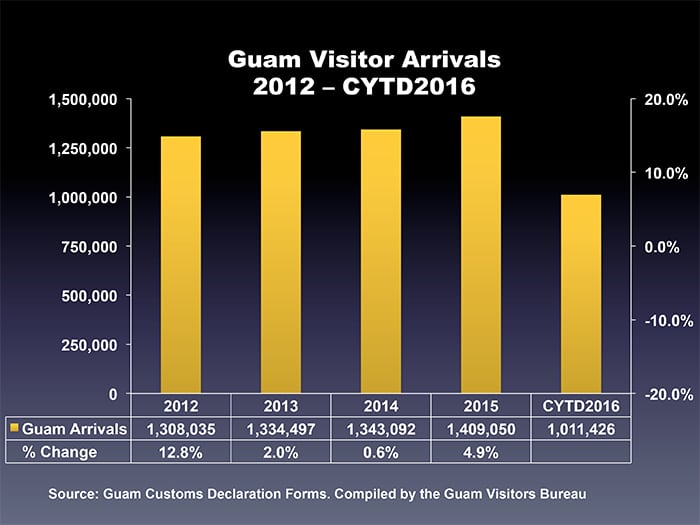Sponsored Listings:
The Pacific Asia Travel Association held its annual conference at the new Dusit Thani Guam Resort in May this year, signaling a shift in strategy for Guam toward capturing more of the lucrative international meetings and incentive travel market.
Since the hotel opened in December 2015, Visit Guam has been positioning the island for North American business events as something resembling a “small Hawaii,” combining the allure of a tropical island destination with the familiarity of American soil.
As a U.S. territory with a mature tourism infrastructure and wide-ranging hotel inventory, Guam enjoys the protections and facilities necessary to support international conferences. Likewise, as the biggest island in Micronesia, located in the Western Pacific roughly two-thirds of the way from Hawaii to The Philippines, the cobalt blue waters and white beaches provide the necessary backdrop for corporate incentive travel programs.
“We refer to ourselves as ‘America in Asia,’ or sometimes as a small Hawaii,” Nathan Denight, president and CEO of Visit Guam, told Skift. “So we’re a fresh and exotic choice for North American meeting planners, but at the same time, we’re a safe and stable environment with U.S. currency and customs.”
For meeting and event venues, Hilton, Hyatt, Sheraton, Westin, Outrigger and a few smaller brands operate properties with mid-size meeting and function space. Total hotel capacity on Guam is around 10,000 rooms.
But it was the opening of the Dusit Thani in December, and its 12,000 square-foot convention center, that really elevated Guam into a more international meetings-friendly destination.
“This is going to bring a new type of business into Guam,” said Chanin Donavanik, CEO of Thailand-based Dusit Hotel International, during the hotel’s grand opening. “I think this is one of the best kept secret destinations, and we need to make the world know more about Guam.”
Also, presently under construction, the new $150 million Tsubaki Tower is scheduled to open in 2018 with 340 rooms and a large amphitheater designed for group events. The developer is Tokyo-based Ken Corp. Ltd., which owns five other hotels on Guam.
“We had to have something that is capable of accommodating MICE (meetings, incentive, conference and exhibition) business,” said Tomoyuki Haneda, director of planning and development for Ken Micronesia, during a press conference in March. “It will be a different type of hotel.”

Guam’s Shifting Travel & Tourism Landscape
Significant shifts in Guam’s source markets and airline capacity are also driving Visit Guam’s decision to push more aggressively into the North American meetings and incentive sector.
Presently, only about 9-10 percent of visitation to Guam is for meetings and incentive travel. The island set a record for overall inbound traffic in 2015, topping 1.4 million visitors, and 2016 should exceed 1.5 million visitors based on present projections. August 2016 air arrivals were up 7.2 percent over the same month last year.
A decade ago, according to Denight, Japanese travelers represented around 90 percent of inbound visitation. Today, that figure is about 55 percent. Likewise, Koreans rarely traveled to Guam 10 years ago, but now their numbers total about 30 percent of annual visitation, making them the second highest feeder market.
China and The Philippines are also on the rise, with China potentially being a tourism juggernaut with new airlift coming online.
The increase in airlift from a wider variety of destinations bodes well for increasing international meetings in Guam. China Airlines launched 4-times weekly service from Taiwan to Guam last October, and Denight says their about to launch a fifth direct flight. EVA Air also flies Taiwan to Guam two times a week.
United Airlines, which has a hub in Guam, launched twice-weekly service to-and-from Shanghai in October 2014. In February this year, United announced it was investing $1-2 million in upgrades in each of its 11 planes based on the island.
“We were not able, for a lot of reasons, to make investments in those aircrafts because we we’re just constantly flying them,” Sam Shinohara, managing director operations Guam and Micronesia for United, told The Guam Daily in February. “We really wanted to bring the best product that we have in the mainland U.S. here into Guam.”
Meanwhile, United, American Airlines, and Japan Airlines all operate multiple daily flights into Guam out of Narita International Airport in Tokyo. United also has an 8-hour non-stop flight from Honolulu.
Introducing Guam to U.S. Meeting Planners
Visit Guam has never really promoted the island to the North American business events market because it was thought that meeting and incentive planners wouldn’t necessarily be interested in a Hawaii-like experience when the real Hawaii was significantly closer to the U.S. mainland.
However, Denight emphasized, as more U.S. companies expand throughout Asia, Guam’s location just 3-4 hours from Japan, China, and Korea becomes a stronger selling point.
“For a small Pacific island, we’re very well connected, and we have over 100 optional tours for groups,” he said. “We’re also the new kid on the block, and I think we’ll see more U.S. delegates as we start to reach out to more American meeting planners.”
In preparation for the IMEX America meetings industry trade show in Las Vegas this month, Visit Guam published a new meetings and incentive guide, and it posted a new brand video last week to show off the island’s leisure pursuits (below), which is relevant for both meeting and incentive planners.
Representatives from both Visit Guam and Dusit Thani are attending IMEX.
The big challenge for Visit Guam to build up its U.S. business group arrivals is the distance from the U.S. mainland. This is a long-term play. To succeed, the bureau will need to invest heavily in more meetings-specific online content, and it will have to show indepth cost comparisons with other Asia-Pacific destinations, to drive its value proposition home.
‘We’re still early in the process,” said Denight. “First we have to make sure we can handle the additional business.”
Source: skift.com










